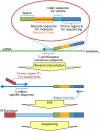Characterization of the T-cell receptor beta chain repertoire in tumor-infiltrating lymphocytes
- PMID: 27465739
- PMCID: PMC5055180
- DOI: 10.1002/cam4.828
Characterization of the T-cell receptor beta chain repertoire in tumor-infiltrating lymphocytes
Abstract
Tumor-infiltrating lymphocytes (TILs) are direct effectors of tumor immunity, and their characterization is important for further development of immunotherapy. Recent advances in high-throughput sequencing technologies have enabled a comprehensive analysis of T-cell receptor (TCR) complementarity-determining region 3 (CDR3) sequences, which may provide information of therapeutic importance. We developed a high-fidelity target sequencing method with the ability for absolute quantitation, and performed large-scale sequencing of TCR beta chain (TCRB) CDR3 regions in TILs and peripheral blood lymphocytes (PBLs). The estimated TCRB repertoire sizes of PBLs from four healthy individuals and TILs from four colorectal cancer tissue samples were 608,664-1,003,098 and 90,228-223,757, respectively. The usage of J- and V-regions was similar in PBLs and TILs. Proportions of CDR3 amino acid (aa) sequences occupying more than 0.01% of the total molecular population were 0.33-0.43% in PBLs and 1.3-3.6% in TILs. Additional low coverage sequencing of 15 samples identified five CDR3 aa sequences that were shared by nine patients, one sequence shared by 10 patients, and one sequence shared by 12 patients. The estimated size of the TCRB repertoire in TILs was significantly smaller than that in PBLs. The proportion of abundant species (>0.01%) in TILs was larger than that in PBLs. Shared CDR3 aa sequences represent a response to common antigens, and the identification of such CDR3 sequences may be beneficial in developing clinical biomarkers.
Keywords: Barcode sequences; T-cell receptor; Tumor-infiltrating lymphocytes; colorectal cancer; next-generation sequencing.
© 2016 The Authors. Cancer Medicine published by John Wiley & Sons Ltd.
Figures





Similar articles
-
T Cell Receptor Beta-Chain Profiling of Tumor Tissue, Peripheral Blood and Regional Lymph Nodes From Patients With Papillary Thyroid Carcinoma.Front Immunol. 2021 Feb 18;12:595355. doi: 10.3389/fimmu.2021.595355. eCollection 2021. Front Immunol. 2021. PMID: 33679738 Free PMC article.
-
TRAV gene expression in PBMCs and TILs in patients with breast cancer analyzed by a DNA melting curve (FQ-PCR) technique for TCR α chain CDR3 spectratyping.Neoplasma. 2012;59(6):693-9. doi: 10.4149/neo_2012_088. Neoplasma. 2012. PMID: 22862170
-
Landscape of tumor-infiltrating T cell repertoire of human cancers.Nat Genet. 2016 Jul;48(7):725-32. doi: 10.1038/ng.3581. Epub 2016 May 30. Nat Genet. 2016. PMID: 27240091 Free PMC article.
-
Current status and recent advances of next generation sequencing techniques in immunological repertoire.Genes Immun. 2016 Apr;17(3):153-64. doi: 10.1038/gene.2016.9. Epub 2016 Mar 10. Genes Immun. 2016. PMID: 26963138 Review.
-
The characteristics of TCR CDR3 repertoire in COVID-19 patients and SARS-CoV-2 vaccine recipients.Virulence. 2024 Dec;15(1):2421987. doi: 10.1080/21505594.2024.2421987. Epub 2024 Nov 4. Virulence. 2024. PMID: 39468707 Free PMC article. Review.
Cited by
-
Biophysicochemical Motifs in T-cell Receptor Sequences Distinguish Repertoires from Tumor-Infiltrating Lymphocyte and Adjacent Healthy Tissue.Cancer Res. 2019 Apr 1;79(7):1671-1680. doi: 10.1158/0008-5472.CAN-18-2292. Epub 2019 Jan 8. Cancer Res. 2019. PMID: 30622114 Free PMC article.
-
Tumor-Infiltrating Lymphocytes and Adoptive Cell Therapy: State of the Art in Colorectal, Breast and Lung Cancer.Physiol Res. 2023 Oct 27;72(S3):S209-S224. doi: 10.33549/physiolres.935155. Physiol Res. 2023. PMID: 37888965 Free PMC article. Review.
-
Biophysicochemical motifs in T cell receptor sequences as a potential biomarker for high-grade serous ovarian carcinoma.PLoS One. 2020 Mar 5;15(3):e0229569. doi: 10.1371/journal.pone.0229569. eCollection 2020. PLoS One. 2020. PMID: 32134923 Free PMC article.
-
Determination of the complexity and diversity of the TCR β-chain CDR3 repertoire in bladder cancer using high-throughput sequencing.Oncol Lett. 2019 Apr;17(4):3808-3816. doi: 10.3892/ol.2019.10015. Epub 2019 Feb 5. Oncol Lett. 2019. PMID: 30881501 Free PMC article.
-
The combination of tumor mutational burden and T-cell receptor repertoire predicts the response to immunotherapy in patients with advanced non-small cell lung cancer.MedComm (2020). 2024 Jun 5;5(6):e604. doi: 10.1002/mco2.604. eCollection 2024 Jun. MedComm (2020). 2024. PMID: 38840771 Free PMC article.
References
-
- Fridman, W. H. , Pages F., Sautes‐Fridman C., and Galon J.. 2012. The immune contexture in human tumours: impact on clinical outcome. Nat. Rev. Cancer 12:298–306. - PubMed
-
- deLeeuw, R. J. , Kost S. E., Kakal J. A., and Nelson B. H.. 2012. The prognostic value of FoxP3+ tumor‐infiltrating lymphocytes in cancer: a critical review of the literature. Clin. Cancer Res. 18:3022–3029. - PubMed
-
- Galon, J. , Costes A., Sanchez‐Cabo F., Kirilovsky A., Mlecnik B., Lagorce‐Pages C., et al. 2006. Type, density, and location of immune cells within human colorectal tumors predict clinical outcome. Science 313:1960–1964. - PubMed
-
- Coulie, P. G. , Van den Eynde B. J., van der Bruggen P., and Boon T.. 2014. Tumour antigens recognized by T lymphocytes: at the core of cancer immunotherapy. Nat. Rev. Cancer 14:135–146. - PubMed
MeSH terms
Substances
Associated data
- Actions
LinkOut - more resources
Full Text Sources
Other Literature Sources

